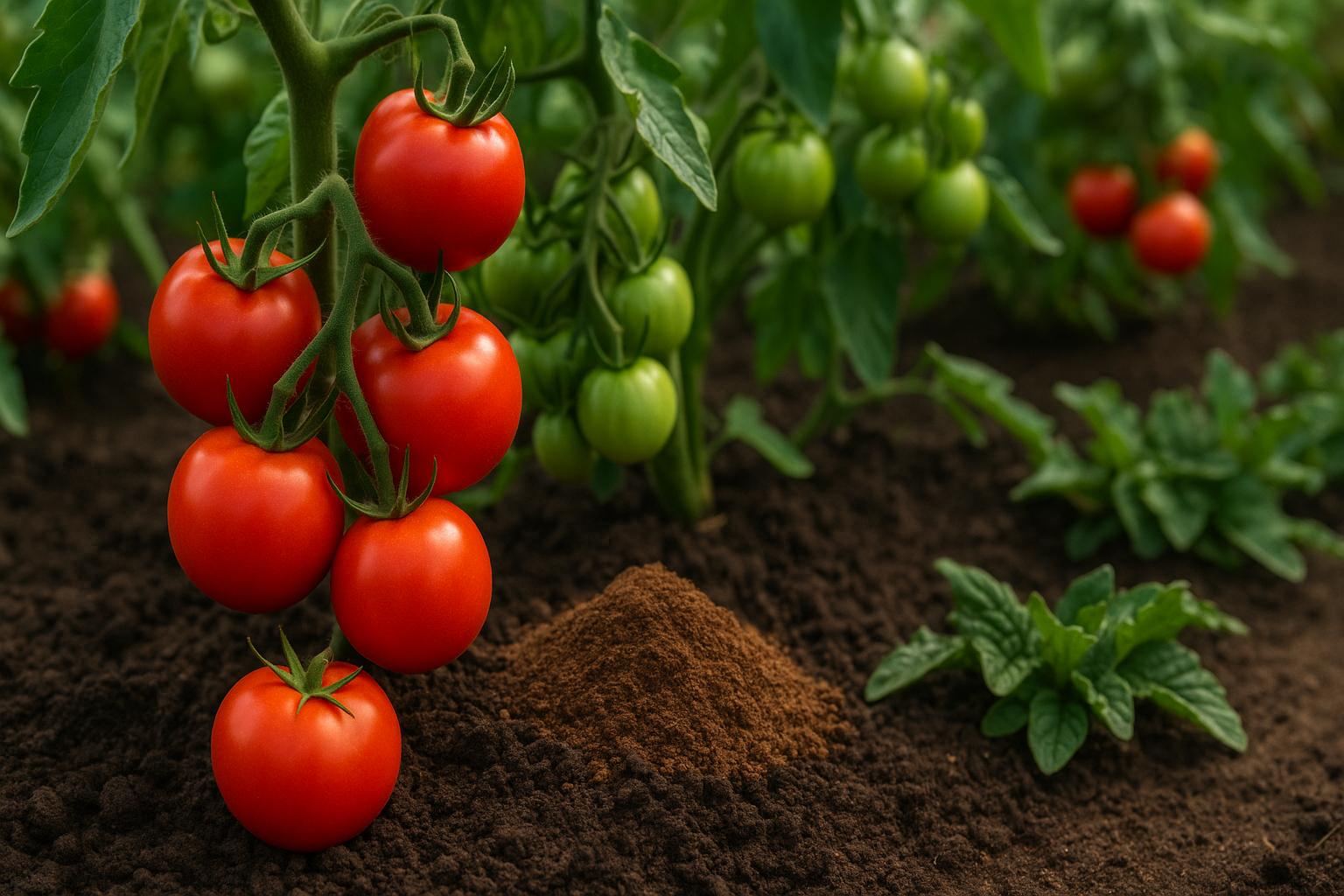The first time I held a fistful of soil and questioned whether it was truly alive, I had no idea how deeply that thought would shape my gardening journey. Growing tomatoes had always been more of a summer ritual than a serious endeavor. Some years were good, some were disappointing, and most fell somewhere in between. But everything changed when I discovered the quiet, powerful world of natural soil enhancers.
My tomatoes didn’t just improve—they exploded with color, taste, and yield. It wasn’t magic, but the result sure felt like it. Here’s the real story of how making simple, science-backed changes to my soil management revolutionized my garden.
Comprehending the Dirt Below
Most people are unaware of the complexity of soil. It is a living ecosystem made up of minerals, fungi, and bacteria that are always interacting; it is more than just dirt. The issue? The majority of soils nowadays have undergone extensive chemical treatment, tilling, and depletion. The findings of my garden soil test were disheartening: compacted layers, minimal organic matter, and an uneven pH of about 5.7.
I needed to be restored, not given more fertilizer. I started using natural soil enhancers at that point.
The Shift to Organic Soil Biology
Natural soil enhancers are materials that boost the soil’s structure, biological activity, and nutrient content—without synthetic chemicals. They work by enhancing microbial life, improving nutrient retention, and building healthier root systems.
Some of the key components I introduced included:
- Composted manure from a local farm, rich in humic acids and slow-release nitrogen.
- Biochar, a carbon-rich material that dramatically improves soil aeration and moisture holding capacity.
After applying these amendments, I gave the soil time to adjust. No overnight miracles—just patience and balance.
Unexpected Gains in the First Season
The changes became obvious by midsummer. My tomato plants were lusher, taller, and greener. The leaves had fewer blemishes. The flowers were denser. The fruit set earlier and more prolifically. I tracked the difference closely:
- Yield increased by 38% compared to the previous season.
- Blossom-end rot, once a chronic issue, was down to less than 2% of fruit.
It was the first time I felt like I was growing food, not just managing plants.
Root Health Was the Gamechanger
I came to see that root health was intimately correlated with soil health. The roots became deeper and more robust as the soil’s microbial richness increased. By facilitating subsurface symbiotic connections, natural enhancers increased the bioavailability of nutrients rather than simply dumping them into the soil.
For instance, mycorrhizal fungi expanded the tomato roots’ access to water and phosphate by colonizing them. These connections are transformative but invisible. Additionally, they can only thrive in settings devoid of chemical barriers and artificial nitrogen overloads.
The Role of Natural Amendments in Fruit Development
It’s one thing to grow a tomato. It’s another to grow one that tastes like sunlight. Flavor, as I learned, comes from a balance of sugar and acid, which is influenced by potassium and calcium availability. Natural enhancers, such as kelp meal and crushed eggshells, helped regulate these minerals.
Higher lycopene levels were indicated by the fruits’ development of thick skins and vivid red meat. They were also less likely to bruise and preserved for a longer period of time. All of this is the result of little changes to soil inputs. No mists. No gimmicks. simply working alongside the earth rather than against it.
I experimented with a number of products in an attempt to improve the outcomes, but Nature Deep for Fruits and Vegetables stood out for long-term balance in vegetable crops. It was in line with regenerative practices and fit in perfectly with my composting process.
Soil Science: A Gateway to Bigger Questions
My exploration into soil health, both physically and figuratively, led me to some intriguing findings. A 2022 study from the Rodale Institute found that compared to conventionally farmed soils, organically managed soils retain 25% more water and three times as much carbon. That’s a climate solution as well as a win for your garden.
Compost-amended soils support increased microbial biodiversity, which is directly linked to plant immunology and pest resistance, according to another compelling finding from the University of California Agriculture and Natural Resources.
It becomes evident that excellent gardening is more about stewardship than control once you comprehend how soil functions.
“The nation that destroys its soil destroys itself.” – Franklin D. Roosevelt
Avoiding the Common Pitfalls
Natural soil enhancers are not silver bullets. They require context. Here’s what I learned from the bumps in the road:
- Overapplying manure can lead to nitrogen spikes, which delays fruiting and causes leafy overgrowth.
- Biochar, while amazing, must be pre-charged with compost or microbial inoculants before use. Otherwise, it leeches nutrients.
It’s easy to overdo a good thing. That’s why I began soil testing bi-annually. With real data, I could target deficiencies instead of guessing.
Introducing Uncommon Enhancers That Made a Difference
While compost and mulch are well-known, here are a few lesser-known allies that delivered outsized results:
- Neem cake: A by-product of neem oil extraction, it deters soil pests and improves nitrogen efficiency.
- Azomite: A volcanic ash powder, rich in trace minerals. It subtly improved fruit size and resilience to heat stress.
These enhancers aren’t mainstream, but they’ve been game-changers in boosting not just productivity, but plant resilience.
FAQs
- How often should I apply natural soil enhancers to my garden?
It depends on your soil’s baseline condition, but typically once in early spring and again after harvest is sufficient. Always test before amending. - Can I use natural soil enhancers in containers or raised beds?
Absolutely. Just ensure proper drainage and monitor nutrient levels more closely since smaller soil volumes can deplete faster. - Do I still need to fertilize if I use natural soil enhancers?
Not necessarily. Many natural enhancers release nutrients slowly. If you notice signs of deficiency, supplement with targeted organic fertilizers. - What’s the biggest mistake gardeners make with soil enhancers?
Assuming more is better. Overapplication can throw your soil balance off. Test, observe, and amend gradually.
Soil is Not a Medium – It’s a Relationship
I no longer consider soil to be merely a planting base after seeing the outcomes. It’s a companion. A living system that requires rest, variety, and care. The harvest of tomatoes was a superficial change. The actual change took place inside my perspective, underground.
I made connections with other farmers who use comparable techniques as a result of this adventure. I discovered whole internet discussion boards devoted to regenerative soil techniques. The Regenerative Growers Guide was one particularly helpful community where professionals exchange case studies and farming practices from all over the world.
Try This Instead of “Conclusion”
Rather than concluding with a summary, consider this: Give it a try. Next season, try growing tomatoes side by side. One bed using standard soil techniques. One that pauses the use of synthetic inputs and incorporates compost and natural boosters. Keep track of the difference.
What the textbooks cannot tell you, let the plants tell you. Reach out and touch the soil. See how it responds. Take note of the texture, the scent, and the way the water drains or doesn’t. Put more faith in nature’s cues than in labels.
You’ll understand when your tomatoes shine on the vine like polished rubies, full of taste, depth, and tenacity. Growing food isn’t all you’re doing. An ecosystem is being revived by you. And what you put into the soil is the first step.






